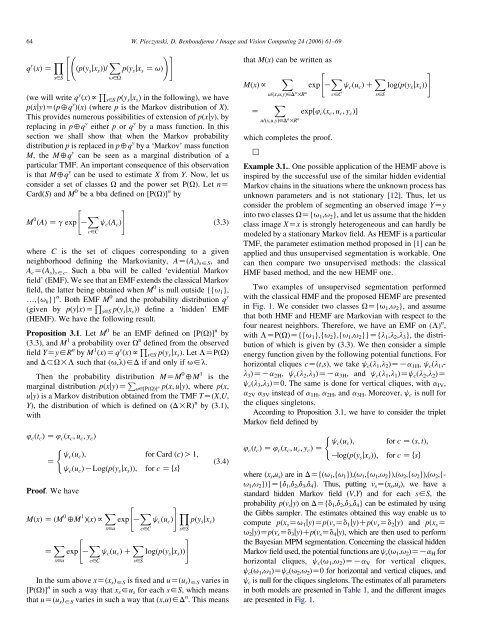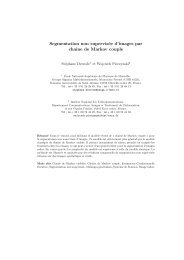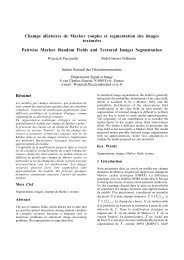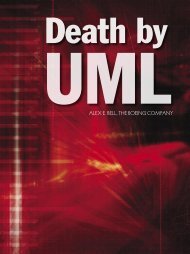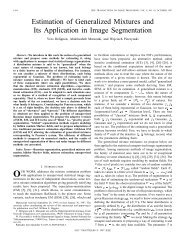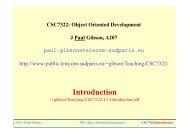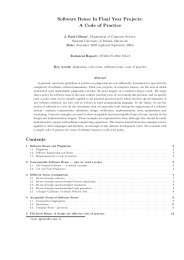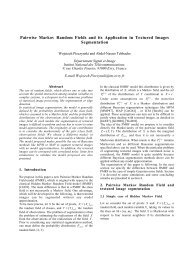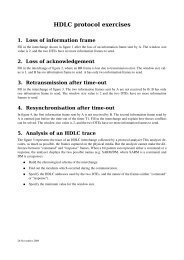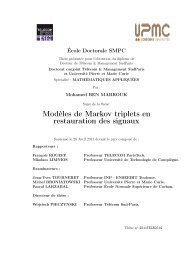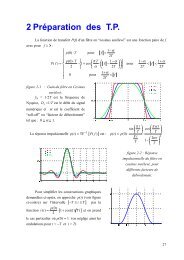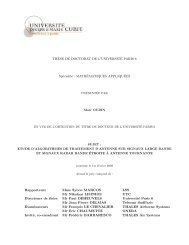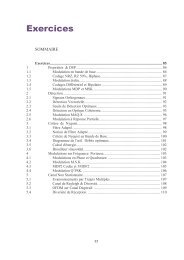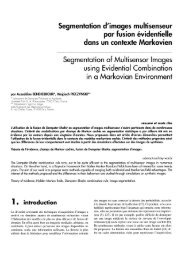Multisensor triplet Markov fields and theory of evidence
Multisensor triplet Markov fields and theory of evidence
Multisensor triplet Markov fields and theory of evidence
Create successful ePaper yourself
Turn your PDF publications into a flip-book with our unique Google optimized e-Paper software.
64<br />
q y ðxÞ Z Y s2S<br />
" !#<br />
ðpðy s jx s ÞÞ= X u2U<br />
pðy s jx s Z uÞ<br />
(we will write q y ðxÞf Q s2S pðy s jx s Þ in the following), we have<br />
p(xjy)Z(p4q y )(x) (where p is the <strong>Markov</strong> distribution <strong>of</strong> X).<br />
This provides numerous possibilities <strong>of</strong> extension <strong>of</strong> p(xjy), by<br />
replacing in p4q y either p or q y by a mass function. In this<br />
section we shall show that when the <strong>Markov</strong> probability<br />
distribution p is replaced in p4q y by a ‘<strong>Markov</strong>’ mass function<br />
M, the M4q y can be seen as a marginal distribution <strong>of</strong> a<br />
particular TMF. An important consequence <strong>of</strong> this observation<br />
is that M4q y can be used to estimate X from Y. Now, let us<br />
consider a set <strong>of</strong> classes U <strong>and</strong> the power set P(U). Let nZ<br />
Card(S) <strong>and</strong> M 0 be a bba defined on [P(U)] n by<br />
" #<br />
M 0 ðAÞ Z g exp K X c2C<br />
j c ðA c Þ<br />
(3.3)<br />
where C is the set <strong>of</strong> cliques corresponding to a given<br />
neighborhood defining the <strong>Markov</strong>ianity, AZ(A s ) s2S , <strong>and</strong><br />
A c Z(A s ) s2c . Such a bba will be called ‘evidential <strong>Markov</strong><br />
field’ (EMF). We see that an EMF extends the classical <strong>Markov</strong><br />
field, the latter being obtained when M 0 is null outside {{u 1 },<br />
.,{u k }} n . Both EMF M 0 <strong>and</strong> the probability distribution q y<br />
(given by pðyjxÞZ Q s2S pðy s jx s Þ) define a ‘hidden’ EMF<br />
(HEMF). We have the following result.<br />
Proposition 3.1. Let M 0 be an EMF defined on [P(U)] n by<br />
(3.3), <strong>and</strong> M 1 a probability over U n defined from the observed<br />
field YZy2R n by M 1 ðxÞZq y ðxÞf Q s2S pðy s jx s Þ. Let LZP(U)<br />
<strong>and</strong> D3U!L such that (u,l)2D if <strong>and</strong> only if u2l.<br />
Then the probability distribution MZM 0 4M 1 is the<br />
marginal distribution pðxjyÞZ P u2½PðUÞŠn pðx; ujyÞ, where p(x,<br />
ujy) is a <strong>Markov</strong> distribution obtained from the TMF TZ(X,U,<br />
Y), the distribution <strong>of</strong> which is defined on (D!R) n by (3.1),<br />
with<br />
4 c ðt c Þ Z 4 c ðx c ; u c ; y c Þ<br />
(<br />
Z j cðu c Þ; for Card ðcÞO1;<br />
j c ðu c ÞKLogðpðy s jx s ÞÞ; for c Z fsg<br />
Pro<strong>of</strong>. We have<br />
MðxÞ Z ðM 0 4M 1 ÞðxÞf X "<br />
exp K X # Y<br />
j c ðu c Þ pðy s jx s Þ<br />
x2u c2C s2S<br />
" #<br />
Z X exp K X j c ðu c Þ C X logðpðy s jx s ÞÞ<br />
x2u c2C<br />
s2S<br />
(3.4)<br />
In the sum above xZ(x s ) 2S is fixed <strong>and</strong> uZ(u s ) 2S varies in<br />
[P(U)] n in such a way that x s 2u s for each s2S, which means<br />
that uZ(u s ) 2S varies in such a way that (x,u)2D n . This means<br />
W. Pieczynski, D. Benboudjema / Image <strong>and</strong> Vision Computing 24 (2006) 61–69<br />
that M(x) can be written as<br />
"<br />
X<br />
MðxÞf<br />
exp K X j c ðu c Þ C X #<br />
logðpðy s jx s ÞÞ<br />
u=ðx;u;yÞ2D n !R n c2C s2S<br />
Z<br />
X<br />
exp½4 c ðx c ; u c ; y c ÞŠ<br />
u=ðx;u;yÞ2D n !R n<br />
which completes the pro<strong>of</strong>.<br />
,<br />
Example 3.1.. One possible application <strong>of</strong> the HEMF above is<br />
inspired by the successful use <strong>of</strong> the similar hidden evidential<br />
<strong>Markov</strong> chains in the situations where the unknown process has<br />
unknown parameters <strong>and</strong> is not stationary [12]. Thus, let us<br />
consider the problem <strong>of</strong> segmenting an observed image YZy<br />
into two classes UZ{u 1 ,u 2 }, <strong>and</strong> let us assume that the hidden<br />
class image XZx is strongly heterogeneous <strong>and</strong> can hardly be<br />
modeled by a stationary <strong>Markov</strong> field. As HEMF is a particular<br />
TMF, the parameter estimation method proposed in [1] can be<br />
applied <strong>and</strong> thus unsupervised segmentation is workable. One<br />
can then compare two unsupervised methods: the classical<br />
HMF based method, <strong>and</strong> the new HEMF one.<br />
Two examples <strong>of</strong> unsupervised segmentation performed<br />
with the classical HMF <strong>and</strong> the proposed HEMF are presented<br />
in Fig. 1. We consider two classes UZ{u 1 ,u 2 }, <strong>and</strong> assume<br />
that both HMF <strong>and</strong> HEMF are <strong>Markov</strong>ian with respect to the<br />
four nearest neighbors. Therefore, we have an EMF on (L) n ,<br />
with LZP(U)Z{{u 1 },{u 2 },{u 1 ,u 2 }}Z{l 1 ,l 2 ,l 3 }, the distribution<br />
<strong>of</strong> which is given by (3.3). We then consider a simple<br />
energy function given by the following potential functions. For<br />
horizontal cliques cZ(t,s), we take j c (l 1 ,l 2 )ZKa 1H , j c (l 1 ,-<br />
l 3 )ZKa 2H , j c (l 2 ,l 3 )ZKa 3H , <strong>and</strong> j c (l 1 ,l 1 )Zj c (l 2 ,l 2 )Z<br />
j c (l 3 ,l 3 )Z0. The same is done for vertical cliques, with a IV ,<br />
a 2V a 3V instead <strong>of</strong> a 1H , a 2H , <strong>and</strong> a 3H . Moreover, j c is null for<br />
the cliques singletons.<br />
According to Proposition 3.1, we have to consider the <strong>triplet</strong><br />
<strong>Markov</strong> field defined by<br />
(<br />
4 c ðt c Þ Z 4 c ðx c ; u c ; y c Þ Z j cðu c Þ; for c Z ðs; tÞ;<br />
Klogðpðy s jx s ÞÞ; for c Z fsg<br />
where (x s ,u s )areinDZ{(u 1 ,{u 1 }),(u 1 ,{u 1 ,u 2 }),(u 2 ,{u 2 }),(u 2 ,{-<br />
u 1 ,u 2 })}Z{d 1 ,d 2 ,d 3 ,d 4 }. Thus, putting v s Z(x s ,u s ), we have a<br />
st<strong>and</strong>ard hidden <strong>Markov</strong> field (V,Y) <strong>and</strong> for each s2S, the<br />
probability p(v s jy) onDZ{d 1 ,d 2 ,d 3 ,d 4 } can be estimated by using<br />
the Gibbs sampler. The estimates obtained this way enable us to<br />
compute p(x s Zu 1 jy)Zp(v s Zd 1 jy)Cp(v s Zd 2 jy) <strong>and</strong> p(x s Z<br />
u 2 jy)Zp(v s Zd 3 jy)Cp(v s Zd 4 jy), which are then used to perform<br />
the Bayesian MPM segmentation. Concerning the classical hidden<br />
<strong>Markov</strong> field used, the potential functions are j c (u 1 ,u 2 )ZKa H for<br />
horizontal cliques, j c (u 1 ,u 2 )ZKa V for vertical cliques,<br />
j c (u 1 ,u 1 )Zj c (u 2 ,u 2 )Z0 for horizontal <strong>and</strong> vertical cliques, <strong>and</strong><br />
j c is null for the cliques singletons. The estimates <strong>of</strong> all parameters<br />
in both models are presented in Table 1, <strong>and</strong> the different images<br />
are presented in Fig. 1.


